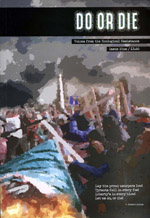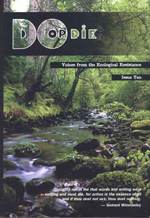Category
Do or Die
-
Do or Die, Most Popular, Periodicals
Do or Die – The Complete Set!
Do Or Die #1-10 (1993-2003, Brighton, England.)
A few years ago a friend asked me if I had a complete set of Do or Die, the British Earth First! publication that inspired and incited eco-warriors throughout the 1990s and early 2000s. At one time I did have them, but they had long since been stolen by a Joint Terrorism Task Force.
After a brief discussion, we decided that Do or Die was too important to fade into obscurity. We began tracking down each issue, and decided that while we were at it we ought to archive some other publications as well. That effort is how this web site began, and now, thanks to 56a infoshop of South London and Tim @ NEDS Northampton, we can finally share the very rare issue #2. This completes our collection, and our original mission as well.
When read as a set, Do or Die is a chronicle of people from across the globe counter-striking capitalism, ecocide, and the state. Each issue is better than the last, but more importantly, each page is a spark licking at the fuse of the bomb that is your heart. Once lit, you’ll know that these pages are not mere history, but a reminder that we can explode onto the world stage like the fighters before us have. Do or die, now is the time to rise.
…
-
Do or Die, Most Popular, Periodicals
Do or Die #10
Do Or Die #10 (2003, Brighton, England.)
It’s hard to believe that it has been a decade since the Do or Die collective published the final issue of their influential, book sized periodical. This last dispatch screamed the same urgent message as its predecessors: Take action now, or die alongside the rest of humanity in the coming ecological meltdown.
In the ten years since our situation has only become more desperate, and therefore the inciting cries for resistance in the pages of Do or Die have only increased in relevance. Plenty has been written on this site about this publication: that it was our reason for starting TALON, that it was the best environmental publication ever, and so on. None of that will matter if DoD’s message is ignored. Read these pages with an eye towards how you will utilize the lessons contained inside. Then, start making plans to create a better world, and implement those plans quickly, because as the title suggests, if you don’t “Do” than our species has only one other option…
The other issues of Do or Die in our archive can be found HERE.
…
-
Do or Die, Periodicals
Do or Die #9
Do or Die #9 (2000, Brighton, England.)
We always write the same thing when we post an issue of Do or Die, so this time we will spare you the superlatives. This issue has worldwide ecological news, human freedom struggles, non-human direct action, and a radical history of football alongside a little bit of humor and many inspiring images. A must read, so click below and get to it!
…
-
Do or Die, Periodicals
Do or Die #8
10.03.12 | Permalink | Comments Off on Do or Die #8Do or Die #8 (1999, Brighton, England.)
There is nothing to say about Do or Die that has not already been said on this website- it was the best environmental journal in history and this issue is full of the same critical theory, inspiring coverage, and beautiful graphics as every other issue. What makes this volume unique though is the in depth coverage of J18, the so-called “Carnival Against Capital” that rocked the world in 1999 before being quickly forgotten. Also of interest is the recurring “Animal Antics” feature, and hundreds of pages of indigenous resistance, radical history, eco-feminism, and direct action coverage. As we have said before, Do or Die is a must read, and this issue is no exception.

-
Do or Die, Periodicals
Do Or Die #1,3,4
06.18.12 | Permalink | Comments Off on Do Or Die #1,3,4Do Or Die #1,3,4. (1993-1994, Brighton, England.)
When a group of five environmentalists gave birth to Earth First! in 1979 they could have hardly imagined how far the movement would spread and how influential its politics would become. From humble roots in the Southwest, chapters began proliferating across the United States and soon left its borders as the worldwide eco-catastrophe inspired people everywhere to take action. In 1992 the first British Earth First! chapter was founded, and within a year one of the most exciting periods of mass direct action in modern history was well underway.
From the start the movement in the UK seemed a little smarter than their US counterparts, perhaps because they had learned from the worst offenses of the fledgling stateside groups. Eschewing the more anti-social elements of American deep ecologists, our comrades across the pond sought to build a broader base and included those working in other movements. They also seemed to have a creative flare for mischief, and their best actions not only stopped the despoilers- they also put a smile on the face of rebels everywhere.
The spectacular campaigns of the UK EF!ers were covered in Do or Die!, a wonderfully self-critical journal that started as a small newsletter and blossomed into a massive annual tome by the end of its existence. Find the other issues HERE.
…
-
Do or Die, Periodicals
Do or Die #7
01.30.12 | Permalink | Comments Off on Do or Die #7Do or Die #7 (1998, Brighton, England.)
The genesis of Conflict Gypsy came from our founder’s desire to collect and preserve a complete set of Do or Die, the classic British Earth First! publication. While we still have not found copies of issues 1-4, our posting of these book sized epics continues with issue #7.
Do or Die was always reasonably free of the acritical cheer leading of it’s many American counterparts, and this issue manages an honest examination of the limitations and capabilities of direct action campaigns from Poland to Brazil to Mexico. As always, there is a bittersweet mixture of inspiration and despair while reading about the clashes between the oppressed and the powers of the state and industry, but there are enough victories contained in this volume that elation prevails! You will cheer as the black bloc escapes arrests in Derbyshire by switching into hippie clothing and shouting “no violence” as the police roll in (An activist in England nearly pissed themselves telling me that story one night!) and as wild boars recruit domesticated pigs for non-human resistance to domestication. The power of villagers in India to stop dams lessens the pain of reading about the paramilitary massacres of people in Acteal, and other articles will have you thinking deeply about our movements DIY media efforts, prison support, and coalitions with labor groups. All in all, another must read from one of the most exciting periods of resistance in the 20th century.

-
Do or Die, Periodicals
Do Or Die #6
09.19.11 | Permalink | Comments Off on Do Or Die #6Do Or Die #6 (1997, Brighton, England.)
“There have been many rational arguments about the usefulness of this action to the campaign, but to anyone who watched the route being transformed from beautiful countryside to churned mud and charred stumps, there is at least a sense of natural justice to the sight of the last tree on route silhouetted by the flames of burning machinery.” -Anon. From the article “Newbury, an adrenaline junkies idea of heaven.”
By the time 1997 rolled around Britons could not help but be aware that something major was afoot in their country. Dock workers were uniting with anti-car anarchists, squatters were preventing the demolition of entire communities by occupying building slated to be torn down, there seemed to be a punk or a hippie in every tree in the whole damned country, and when police got in the way they faced riots as a result. Amidst this flurry of activity though, those on the inside knew that their movement was in terrible danger from forces both internal and external. With time short and resources low they began to discuss how to prevent catastrophe. In the end they failed, but they left behind a wonderful warning of what happens when we analyze our tactics, morale, and outreach too late.
This is not to say that Do Or Die #6 is a doom and gloom journal of a dying movement. Much to the contrary, this issue foresaw the collapse but was written when activity was still peaking. Amongst the analysis of their campaigns and politics, Earth First in the UK and Europe as a whole found plenty of time to get down to the joyous work of resisting industry and capital. There is no way that one can not read some of the stories inside without feeling a boost of adrenaline. From the theft of bulldozers to destroy a construction site to the rampaging of drunken elephants against military bases, to the building of a free state on american soil, all variety of species get down to the usual business of ruining business as usual. Inspiration abounds!

…
-
Do or Die, Periodicals
Do or Die #5
07.02.11 | Permalink | Comments Off on Do or Die #5Do Or Die #5 (1995, Brighton, England)
The story of Earth First! in the United States is well documented and frequently repeated, and someday it will certainly make it’s way to digital distribution here on Conflict Gypsy. (Scanning those hundreds of copies of EF! Journal is going to put our volunteers into early graves if we are not careful, so don’t expect to see a full set anytime soon!) Until that time it is our pleasure to delve into the history of Earth First! elsewhere in the world, starting in England and the other places still under colonial rule known as the “United Kingdom.”
Beginning in 1991 there was an explosion in activism across the pond. Wilderness, urban environmental, anti-road, alternative transportation, animal liberation, anarchist, squatters rights, and other specialized, single issue activist realms began to coalesce into an exciting new mass. The origins of this widespread movement had broad roots. Some trace its beginnings to the poll tax riots, others say it was government crack downs on raves, squats, and social centers. Where ever it came from, it grew within a few short years into a spectacular and inspiring mess for the status quo!
From encampments protecting wild areas, to sabotage, to street protests that took over whole city centers, the UK suddenly seemed alive with resistance. While never reaching a size that threatened the powers that be, these outbursts of love and aggression were never the less refreshing to those of us in the United States longing for a similar explosion in revolutionary zeal. Suddenly, Do Or Die became the must read publication that no-one could quite seem to get their hands on!
Professionally bound and book sized, each issue of DoD contained news, research and analysis about the exploits of radical activists worldwide. Conflict Gypsy will be posting a full set of these journal format prizes as they become available to us. The earliest issue in our collection, #5, contains lengthy articles on the live export protests that eventually ended with the death of Jill Phipps, the NO M65 campaign, and virtually everything else worth noticing in Europe in 1995. If you have earlier editions of DoD, please contact us at conflictgypsy (at) gmail (dot) com

…










